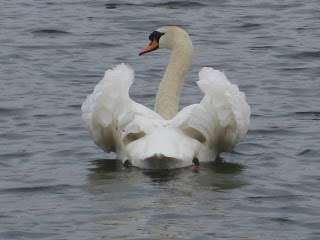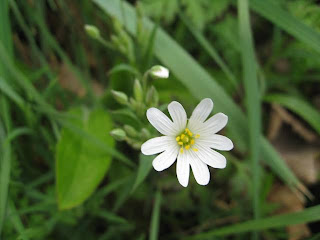 Yellow Archangel
Yellow Archangel White Dead-nettle
White Dead-nettle Dandelions
Dandelions23rd April. I had a short meeting to attend at the Rising Sun Country Park so took the chance of a little birding on the walk there and in the park itself. The park seemed quiet in terms of birdlife, but the facilities were being put to very good use by several coach loads of youngsters, which was good to see. I couldn’t help but smile when I heard one young lad say to his mate ‘this walking around is boring’. He sounded just like me at his age! At his age too, I can only ever recall knowing the song and calls of Cuckoo, Tawny Owl and House Sparrows. The latter I knew well as they were all over the place on my walks to school. I can only ever remember hearing one Cuckoo in the countryside as a child and that was on a Sunday morning on a visit to Derby of all places. It’s strange how this has stayed with me. I understand my high frequency hearing began to go down hill in my twenties so perhaps mine may be a little cream crackered now, but it hasn’t stopped me trying to get to grips with song and calls which I think is so important to bird watching. The importance was reinforced in my mind when on one or two birding tours I noted the final list would have been well down without someone’s expertise in tracking down calls.
So where once upon a time bird song would have been an ignored background noise to me, or even an early morning annoyance, I’ve been taking a growing interest in listening as well as watching for sometime now. Now on my walk yesterday there wasn’t anything of real note (if you’ll excuse the pun) around bird wise, but never the less quite a lot of song. Bird song and calls I recall on my walk included Mute Swan (2 flying over my home as I left), Pheasant, Herring Gull, Wood Pigeon, Collared Dove, Skylark, Swallow, Wren Dunnock, Robin, Blackbird, Willow Warbler, Chiffchaff, Great Tit, Blue Tit, Long Tailed Tit, Magpie, Jackdaw, Rook, House Sparrow, Chaffinch, Linnet and Greenfinch. I have missed some and not included the waterfowl at Swallow Pond. I think undoubtedly the Black Headed Gulls there won hands down in the ‘noise’ stakes. Lots of Lapwing calls today too. On my return I think I may have heard a Sparrowhawk, but the noise outside of Asda ruined any chance of confirming that and I certainly didn’t sight it.
I find listening to the songs of the common birds above very useful, in that when something less common is heard I may not know what it is, but at least I know what it isn’t and can investigate a little more. I’m not that good at identifying birdsong and have to re-learn the warblers each spring! I also rely on habitat clues and find learning much easier that way rather than trying to rely on my recordings on CD, which never the less are still a useful learning tool. If someone played me recordings of songs outside of their usual habitat that I reckon would throw me completely, but I am getting better slowly and I’m still learning, high pitch hearing problem or not.
I’m pleased I ended up with a list of 42 species on what wasn’t really a birding expedition. I was also advised as to a good spot to find Lesser Whitethroat by one of the local birders. At the moment I’d settle for any Whitethroat!
I also found some decent botanical interest, much of it outside of the park although there will be some interesting plants come into flower in there soon. Even the Dandelions looked good today. Other plants found included Marsh Marigold Caltha palustris, Lesser Celandine Ranunculus ficaria, Red Campion (very pale so I reckon hybrid of red and white) Silene dioica, White Dead-nettle Lamium album , Yellow Archangel (garden escape variety) Lamiastrum galeobdolon argentatum, Ground Ivy Glechoma hederacea and Cuckooflower Cardamine pratensis. I believe the latter is called such as it flowers at a time when the first Cuckoos are heard in spring, which takes me back to where I began with my childhood Cuckoo.
So where once upon a time bird song would have been an ignored background noise to me, or even an early morning annoyance, I’ve been taking a growing interest in listening as well as watching for sometime now. Now on my walk yesterday there wasn’t anything of real note (if you’ll excuse the pun) around bird wise, but never the less quite a lot of song. Bird song and calls I recall on my walk included Mute Swan (2 flying over my home as I left), Pheasant, Herring Gull, Wood Pigeon, Collared Dove, Skylark, Swallow, Wren Dunnock, Robin, Blackbird, Willow Warbler, Chiffchaff, Great Tit, Blue Tit, Long Tailed Tit, Magpie, Jackdaw, Rook, House Sparrow, Chaffinch, Linnet and Greenfinch. I have missed some and not included the waterfowl at Swallow Pond. I think undoubtedly the Black Headed Gulls there won hands down in the ‘noise’ stakes. Lots of Lapwing calls today too. On my return I think I may have heard a Sparrowhawk, but the noise outside of Asda ruined any chance of confirming that and I certainly didn’t sight it.
I find listening to the songs of the common birds above very useful, in that when something less common is heard I may not know what it is, but at least I know what it isn’t and can investigate a little more. I’m not that good at identifying birdsong and have to re-learn the warblers each spring! I also rely on habitat clues and find learning much easier that way rather than trying to rely on my recordings on CD, which never the less are still a useful learning tool. If someone played me recordings of songs outside of their usual habitat that I reckon would throw me completely, but I am getting better slowly and I’m still learning, high pitch hearing problem or not.
I’m pleased I ended up with a list of 42 species on what wasn’t really a birding expedition. I was also advised as to a good spot to find Lesser Whitethroat by one of the local birders. At the moment I’d settle for any Whitethroat!
I also found some decent botanical interest, much of it outside of the park although there will be some interesting plants come into flower in there soon. Even the Dandelions looked good today. Other plants found included Marsh Marigold Caltha palustris, Lesser Celandine Ranunculus ficaria, Red Campion (very pale so I reckon hybrid of red and white) Silene dioica, White Dead-nettle Lamium album , Yellow Archangel (garden escape variety) Lamiastrum galeobdolon argentatum, Ground Ivy Glechoma hederacea and Cuckooflower Cardamine pratensis. I believe the latter is called such as it flowers at a time when the first Cuckoos are heard in spring, which takes me back to where I began with my childhood Cuckoo.



















